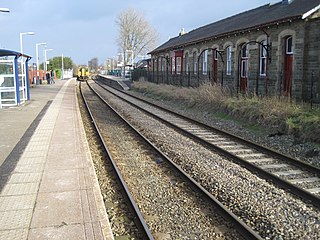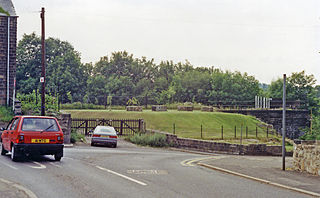
Grimethorpe is a large village in the metropolitan borough of Barnsley in South Yorkshire, England. Historically within the West Riding of Yorkshire, it had a population of 4,672 at the 2011 census. Grimethorpe is located to the east of Barnsley and south of Hemsworth; until the local government reorganisation of 1974, it was part of the Hemsworth district and constituency. At the 2011 Census the village was part of the North East ward of Barnsley MBC.

The Lancashire and Yorkshire Railway (L&YR) was a major British railway company before the 1923 Grouping. It was incorporated in 1847 from an amalgamation of several existing railways. It was the third-largest railway system based in northern England.

The South Yorkshire Joint Railway was a committee formed in 1903, between the Great Central Railway, the Great Northern Railway, the Lancashire and Yorkshire Railway, the Midland Railway and the North Eastern Railway to oversee the construction of a new railway in the Doncaster area of South Yorkshire, England. The five companies had equal rights over the line, each of the companies regularly working trains over it.
The Wakefield line is a railway line and service in the West Yorkshire Metro and South Yorkshire Passenger Transport Executive areas of northern England. The Wakefield line is coloured yellow on maps and publications by West Yorkshire Metro. The line was electrified in 1989, between Leeds & Wakefield Westgate, as part of the programme to electrify the East Coast Main Line.

The Ribble Valley line is a railway line that runs from Manchester Victoria through Blackburn to Clitheroe in Lancashire. Regular passenger services normally only run as far as Clitheroe, but occasional passenger services run along the line through north Lancashire towards the Yorkshire village of Hellifield, where it joins the Settle-Carlisle Railway. The line passes over the distinctive 48 span Whalley Viaduct.

Edlington is a town and civil parish in the Metropolitan Borough of Doncaster, South Yorkshire, England, lying to the south west of Doncaster and Warmsworth. It has a population of 8,276. The original parish town of Edlington is now known as Old Edlington; adjacent, and to the north, is New Edlington. It is often referred to by locals as 'Edlo'. Since 1974 Edlington has been part of the Metropolitan Borough of Doncaster in the metropolitan county of South Yorkshire. It had, since 1894, formed part of Doncaster Rural District in the West Riding of Yorkshire.
The South Yorkshire Railway was a railway company with lines in the West Riding of Yorkshire, England.

Denaby Halt was a small railway station on the Dearne Valley Railway (DVR), intended to serve the mining community of Denaby Main in South Yorkshire, England, although it was some distance from there, in what was described as "a marshy wilderness". The station was opened on 3 June 1912. Its full title, as shown on its nameboard, was Denaby for Conisboro' and Mexboro. The halt was located between Edlington Halt, the eastern passenger terminus of the line and Harlington Halt.
Harlington Halt was a small railway station on the Dearne Valley Railway (DVR) located close by Harlington village, near Mexborough, South Yorkshire, England.
Goldthorpe and Thurnscoe Halt was a small railway station on the Dearne Valley Railway (DVR) situated between Harlington Halt and Great Houghton Halt. It served the village of Goldthorpe in South Yorkshire, England.
Great Houghton Halt was a small railway station on the Dearne Valley Railway (DVR) situated between Goldthorpe and Thurnscoe Halt and Grimethorpe Halt. The halt served the village of Great Houghton in South Yorkshire, England.
Grimethorpe Halt was a small railway station on the Dearne Valley Railway (DVR) situated between Great Houghton Halt and Ryhill Halt. It served the village of Grimethorpe, South Yorkshire, England.

Edlington railway station was a small railway station at the eastern terminus of the Dearne Valley Railway. The station's full title as shown on the station nameboard is "Edlington for Balby Doncaster". It was built to serve the mining village of Edlington and the Doncaster suburb of Balby in South Yorkshire, England.

The A6195 road runs through the Dearne Valley in South Yorkshire, England.

Britannia railway station served Britannia near Bacup, Lancashire, England, from 1881 until closure in 1917. The station was just to the west of the summit of the line, which was also the highest point on the entire Lancashire and Yorkshire Railway (LYR) system.

Darfield railway station was opened in 1840 by the North Midland Railway, serving the village of Darfield in South Yorkshire, England.

Ryhill Halt railway station in Ryhill, West Yorkshire, England was a small railway halt on the Dearne Valley Junction Railway, a branch of the Lancashire and Yorkshire Railway which connected it to the Dearne Valley Railway. It was situated between Wakefield Kirkgate and Grimethorpe. It was opened for passenger traffic on 3 June 1912 and closed, along with others on the line on 10 September 1951.
The Hull and Doncaster Branch is a secondary main railway line in England, connecting Kingston upon Hull to South Yorkshire and beyond via a branch from the Selby Line near Gilberdyke to a connection to the Doncaster–Barnetby line at a junction near Thorne 8 miles northeast of Doncaster.
The Sheffield, Rotherham, Barnsley, Wakefield, Huddersfield and Goole Railway was an early British railway company. The company obtained an act in 1846 for 26 miles of railway, with a main section from Wakefield to Doncaster via Barnsley.

Conisbrough Viaduct is a former railway viaduct, near to Cadeby and Conisbrough in South Yorkshire, England. The viaduct consists of two sections of brick and stone on each bank, connected by a lattice girder section, some 113–116 feet (34–35 m) over the River Don. The height and space were required should shipping need to navigate along the river. The viaduct carried the Dearne Valley Railway over the River Don between 1909 and 1966, after closure it was converted into a foot and cycle path. The structure is grade II listed, and is notable for being one of the first bridges in Britain to be built using a rope system above the viaduct known as a "Blondin".















